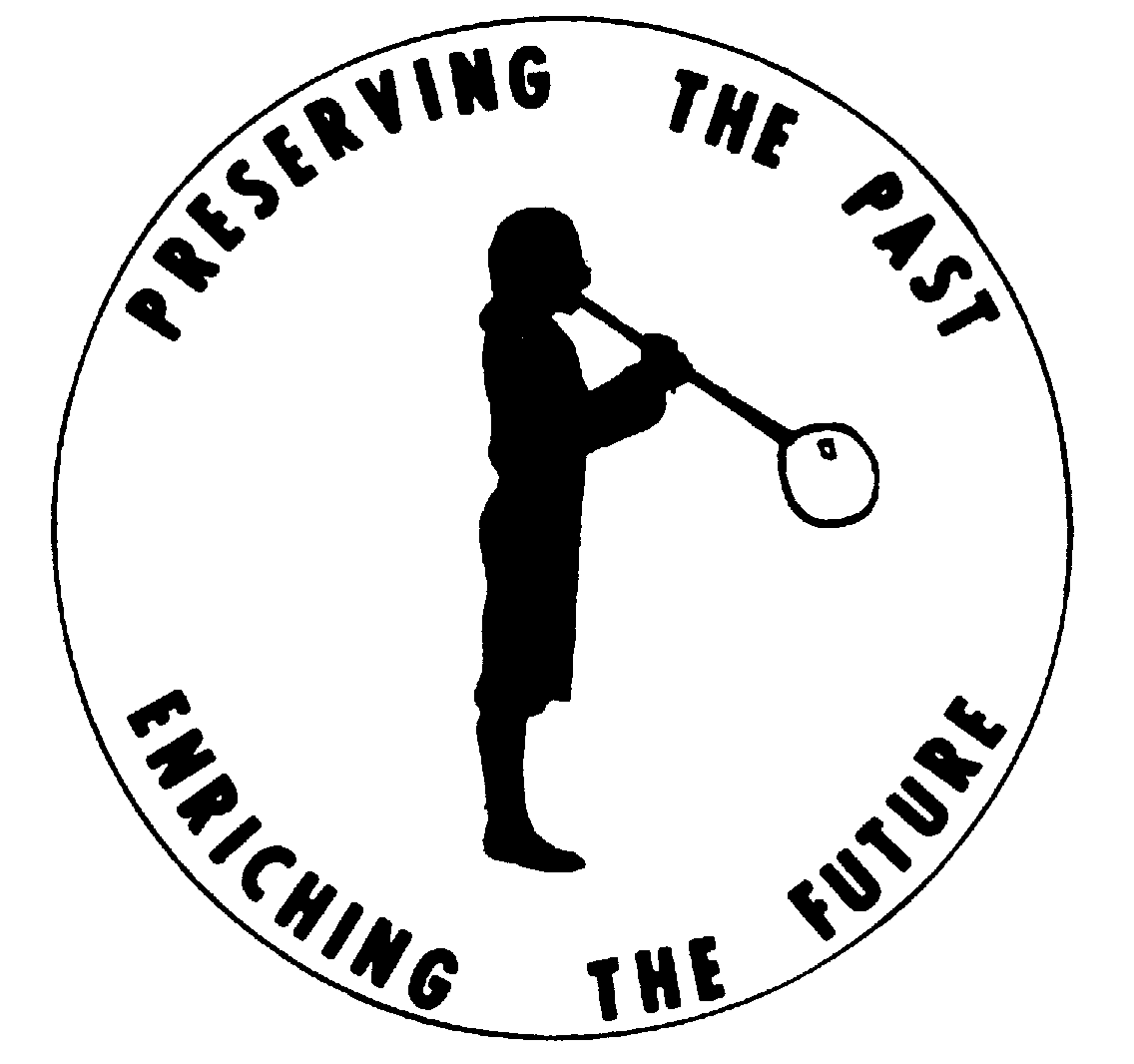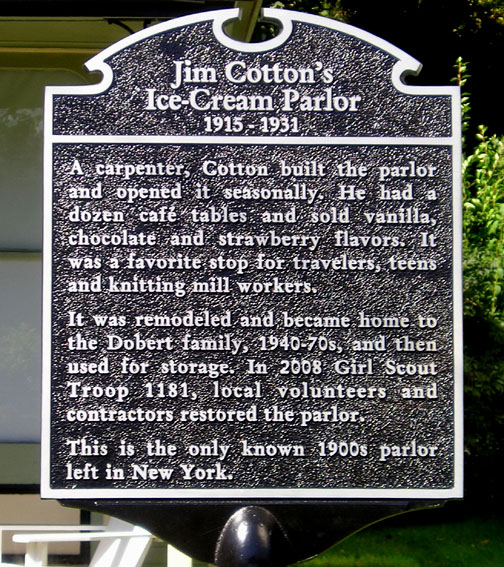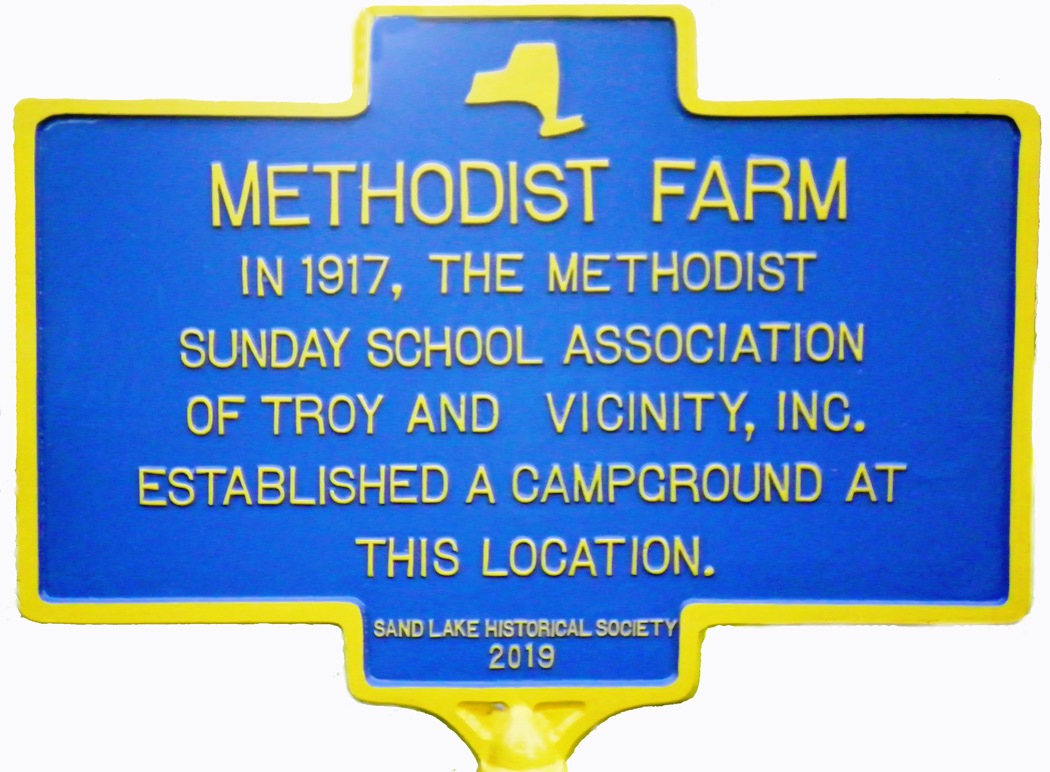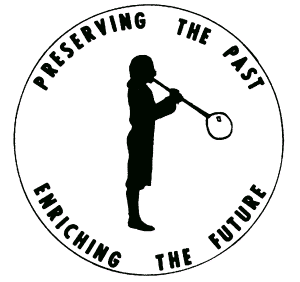
 |
Historical HighlightsHistorical Markers in the |
Until a few years ago, Sand Lake had but one historical marker in the town. |
Trinity Lutheran ChurchThat "lone marker" is the one in front of the former Trinity Lutheran Church (currently West Sand Lake Community Church) and makes reference to the wooden structure that was erected in 1816 and then burned in 1944.The church's history is interesting. A group of Lutheran settlers formed a church in this area in 1776. Their church was log construction, built in Rensselaerwyck about one mile southwest of West Sand Lake on the present Thomas I. Cipperley property. Title to the land was purchased from Stephen Van Rensselaer in 1801. Zion Evangelical Lutheran Church opened in 1816 at the West Sand Lake site. Its history meshes with the Second Evangelical Lutheran Church.In 1838, parishioners left the Zion Evangelical Lutheran Church over the issues of antislavery and temperance and formed the Second Evangelical Lutheran Church. This church was a station on the Underground Railroad for fugitive slaves. Rev. Nickolas Van Alstyne, with the secret name "Paul," gave messages in code during Sunday sermons for abolitionists' meetings and the movement of slaves to freedom. Zion's Lutheran then became the First Evangelical Lutheran Church. In 1926, the congregations of the First and Second Evangelical Lutheran churches reunited and became Trinity Lutheran Church. Services were held in the original Zion Evangelical, or First Evangelical Lutheran Church. The building was struck by lightning and burned on August 14, 1944. Between 1944 and 1954, services were held in the Second Evangelical Lutheran Church building while the present brick building was being completed. The site of the Second Lutheran Church is the present Sand Lake Dry Cleaning and Laundromat. (Location: West Sand Lake, Rt. 150.) |
Marker erected by the State Education Department, 1938. |
In the late 1990s, Town Historian Judy Rowe began an emphasis on getting deserving sites identified with historical markers. |
|
Bernhard UhleinThe first marker of this initiative was donated by the Uline Family Association in memory of Bernhard Uhlein, who served in the Revolutionary War. He was a Palatine German who arrived in Philadelphia as an indentured worker. He made his way to Rensselaerwyck's East Manor and received a 325-acre grant of land from the Patroon VanRensselaer. His farm became known as Ulinesville and in 1838 it was named West Sand Lake. (Location: West Sand Lake, Rt.150 and Shaver Rd.) |
Marker sponsored by the Uline family. |
Sand Lake Union CemeteryThe Sand Lake Union Cemetery Association purchased a sign to mark the formation of the Cemetery in 1841 from the Rensselaer Glass Factory and Woodbine cemeteries. The earliest marked gravestone is 1807. In addition to many Revolutionary and Civil War gravesites, James Averill's horse Moscow is buried on the Averill plot. The Averill family had Moscow's grave marked a few years ago. Also there is the grave of Dr. Smith Boughton, who was known as "Big Thunder" during the Anti-Rent War. (Location: Sand Lake, Routes 43 and 66.) |
Marker sponsored by the Sand Lake Union Cemetery Association. |
Burden LakeThe Burden Lake Association sponsored a sign noting that the three Burden Lakes were formed by the Wynantskill Improvement Association. Water from Wynantskill Creek flows from its headwaters at Glass Lake. Over the years, the Wynantskill was used for water power by the many mills along its banks in the town of Sand Lake, Albia and Troy until it reached its terminus in South Troy, where it powered the second largest water wheel in the world at the Burden Iron Works. (Location: the "triangle" at Sheer, Burden Lake and First Dyke Roads.) See also Burden Lake and Sand Lake -- Mill Town. Sadly, this sign "went missing" sometime in 2005, but the Burden Lake Association purchased and installed a replacement sign in summer 2007. |
Marker sponsored by the Burden Lake Association, 2003. |
Glass Lake / Glass HouseJeremiah Van Rensselaer founded the Rensselaer Glass Factory in 1804. The village on this site consisted of 34 workers' homes, a store, pottery, ashery, school, doctor's office, wood cutters' cabins, a home for the factory superintendent, a home for the superintendent in charge of glass making, horse barns, warehouses, cylinder packing house and boarding houses. The land consisted of a wood lease from Patroon Van Rensselaer of 5000 acres and 346 acres around the lake. Glass Lake is also the headwaters of the Wynantskill Creek and makes its journey as described for the Burden Lake marker (above). (Location: Glass Lake, Routes 43 and 66 at Glass Lake Rd.) |
Marker sponsored by the Sand Lake Historical Society. |
Sand Lake Baptist ChurchThe Sand Lake Historical Society purchased this marker. Sand Lake Baptist Church, the oldest public building in the Town of Sand Lake, was erected in 1805 as a meetinghouse for Baptists, Methodists and Presbyterians. The Methodists sold their meetinghouse rights to the Presbyterians in 1831 and built their church at Glass Lake. In 1835, the Presbyterians sold their portion of the church to the Baptists and erected a church at the corner of Routes 43 and 66 in Sand Lake (now the Sand Lake Center for the Arts). On December 29, 1831, 18 believers were set apart to form an independent Baptist Church to be known as the "Second Baptist Church of Sand Lake." (After the town of Poestenkill was formed from part of the town of Sand Lake in 1848, the First Baptist Church changed its name to Poestenkill Baptist Church and the Second Baptist Church was called Sand Lake Baptist Church.) In 2004, the church was named to the National Register of Historic Places. (Location: Averill Park, Route 43.) |
Marker sponsored by the Sand Lake Historical Society, 2004. |
Faith MillsFrom the early 1800s up to 1966, any number of factories that produced knit cotton and woolen goods, warp yarn and paper dotted the landscape along the present Burden Lake Road. One of the most notable and enduring was Faith Mills, which finally ceased operations in 1966. (Location: Averill Park, on Burden Lake Road off Route 43.) See reminiscences of those connected with the Faith Mills complex. |
Marker sponsored by the Sand Lake Historical Society, 2005. |
Log Church Site, 1776An historical marker now designates the site of the first church building in the town. It was a log building serving as pastor’s home, schoolhouse and Lutheran church located on the present Thomas I. Cipperley property. Several stones from the cemetery are preserved at Eastfield Village. The church was the forerunner of the Zion’s Evangelical Lutheran Church, which opened in 1816. (Location: West Sand Lake, off Route 43 on Best Road at the intersection of Parker Road.) |
|
Cotton HouseJim Cotton's Ice-Cream Parlor A carpenter, Cotton built the parlor and opened it seasonally. He had a dozen café tables and sold vanilla, chocolate and strawberry flavors. It was a favorite stop for travelers, teens and knitting mill workers. It was remodeled and became home to the Dobert family, 1940-70s, and then used for storage. In 2008 Girl Scout Troop 1181, local volunteers and contractors restored the parlor. This is the only known 1900s parlor left in New York. More about the Cotton House. |
 |
District 1 School HouseThis marker designates the site of the school house for "District 1" on Sheer Road, a one-room school house circa 1895-1929. (Location: on the west side of Burden Lake, on Sheer Road, north of Biittig Road.) More about the this and other schools prior to 1929 | Read about the dedication of this marker! |
|
Methodist FarmOur newest historical marker will be unveiled and dedicated on July 6, 2019, at the entrance to Methodist Farm, on the southern end of Crooked Lake. More about Methodist Farm |
 |
In addition to these markers, negotiations are underway for a marker at West Sand Lake for Underground Railroad activities.The Sand Lake Historical Society would like to see this project continue. You can help by letting the Historical Society or Town Historian know of additional sites deserving of historical markers, businesses and/or organizations willing to contribute to the erecting of future historical markers, and individuals who would like to contribute toward a marker's purchase.And we can all remember to point these markers out to persons when we conduct an impromptu tour!-- Mary French, from Historical Highlights Volume 31, Number 1, Fall 2004, and Volume 35, Number 3, Spring 2009; additional information by Bob Lilly, Andrew Mace and others.More about historical markers locally and beyond
|
|
 |
Have any suggestions for historical markers in Sand Lake? If so, please contact us! |
 August 10, 2007; revised
June 19, 2019
-- asm. © 2002-2024 Sand Lake Historical Society; all rights reserved.
August 10, 2007; revised
June 19, 2019
-- asm. © 2002-2024 Sand Lake Historical Society; all rights reserved.